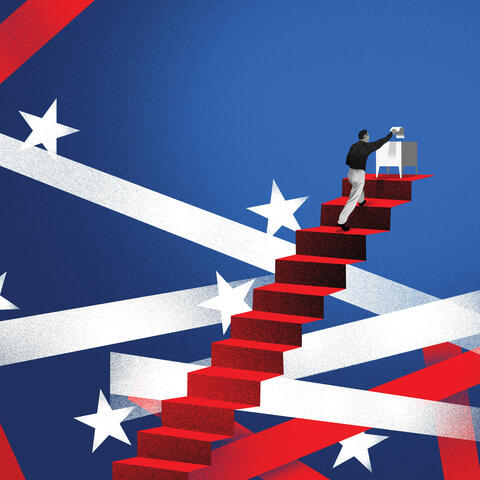From Slavery to Suburbia
African Americans and the problem of property

Research at Risk: Since World War II, universities have worked with the federal government to create an innovation ecosystem that has yielded life-changing progress. Now much of that work may be halted as funding is withdrawn. Find out more about the threats to medical, engineering, and scientific research, as well as how Harvard is fighting to preserve this work—and the University's core values.
In her forthcoming book, No More Auction Block for Me: African Americans and the Problem of Property, Shirley Thompson, PhD '01, examines the legacies of slavery for African American encounters with property and ownership. An associate professor and associate chair of American Studies at the University of Texas at Austin, Thompson says the notion of black people as property is deeply embedded in the cultural, political, and legal DNA of the United States.
How did the concepts of race and property become interwoven?
Racial slavery. The commodification of Africans and their descendants, their transportation across the Atlantic as commodities, and their sale into slavery in the Americas all yoke the concept of blackness as a racial category together with status as an article of property. It becomes institutionalized in the mid-1600s in Virginia with a series of race-based laws that binds laborers of African descent to their masters for life—and binds their children and their children’s children as well. Then, in the constitutional period, enslaved people are classified as three-fifths of a human being and consigned to the status of property in the other two-fifths of their body.
In practice, this dichotomy is drawn on selectively to reinforce white supremacy throughout US history. For example, in March 1857, United States Supreme Court Chief Justice Roger B. Taney writes for the majority in Dred Scott v. John Sanford that Blacks have always been “treated as an ordinary article of merchandise and traffic.” Therefore, they “had no rights which the white man was bound to respect.” It’s that history, the legacy of that status, that I want to begin to unpack in Black institutional culture, theorizing, and literary works in the aftermath of slavery.
In the constitutional period, enslaved people are classified as three-fifths of a human being and consigned to the status of property in the other two-fifths of their body.
—Shirley Thompson
How have the legacies of slavery influenced African American encounters with property and ownership since abolition?
One of the institutions I’ve been studying is the African American life insurance company. Black people were considered too risky to insure. You can understand why. They were faced with white supremacist violence—lynching, rape—as well as a lack of access to health care. So you could do a very “objective” analysis of lifespans in this period and come up with a calculation that valued whiteness and white middle-class maleness, in particular, and devalued people who didn’t measure up to that standard.
African American companies grow out of informal mutual aid societies and eventually transform themselves into corporate entities, offering life insurance to the community. This is an example of Black capitalism—African Americans trying to build institutions that will allow them to tap into the economic potential of financial markets. These Black institutions begin to build themselves up until they eventually look like mainstream insurance companies.
In the process, though, they begin to diverge from the mutual care model and reinforce some of the same violence of commoditization of human life, making people fit the numbers in ways that echo the same logic of enslavement. There’s a mixed legacy there.
Without historicizing, what are some of the ways that race and property continue to be interwoven in our society and our culture today?
It is difficult not to historicize when we look at real estate markets and the way the 2008 mortgage crisis disproportionately devastated people in Black communities whose wealth was bound up in real estate and who were targets of subprime lending. Think about suburbanization in the 1940s and 1950s. That process created immense wealth for white property owners while throwing up barriers for Black access to mortgages and homes. It was part of a longstanding process that keeps Blacks in certain regions and then devalues the property in those spaces. We can track this process across any US city. Blacks move into a neighborhood, and whites panic and flee, setting in motion a deflation of property values until developers target the area for revitalization. It’s a series of cycles, right?
How do those in the Black community employ music, art, and literature to assert their dignity in the face of objectification?
Think of the recording industry, for instance. Throughout the 20th century, it tries to capture Black speech, the Black singing voice, Black music, Black dance, or other kinds of expressive culture and make them available to the market. None of it puts an end to the fugitive aspects of Black music in a place like New Orleans, for example—the second-line bands, and the jazz funerals, which are directly linked to the old mutual aid societies. That music continues to function in nonmarket ways in these communities of care and support in ways that fly under the radar of the music industry. That continues to this day. You have a strong tradition of New Orleans funk, R&B, and then hip hop and bounce music that has recently become popular but had functioned in New Orleans long before its national popularity as a kind of lingua franca and spiritual salve for ordinary people.
Curriculum Vitae
- University of Texas
- Associate Professor of African and African Diaspora Studies 2010-Present
- Associate Professor of American Studies 2009-Present
- Assistant Professor of American Studies 2001-2009
- Harvard University
- Instructor, History and Literature 2000-2001
- Teaching Fellow, History and Literature 1998-2000
- University of Southern Maine
- Adjunct Instructor, Women’s Studies Spring 1998
- Lewiston-Auburn College
- Adjunct Instructor, Humanities Fall 1997
Get the Latest Updates
Join Our Newsletter
Subscribe to Colloquy Podcast
Simplecast





